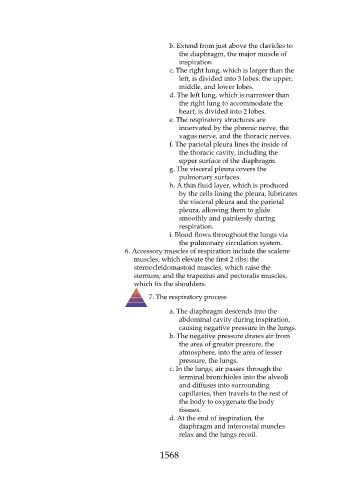Page 1568 - Saunders Comprehensive Review For NCLEX-RN
P. 1568
b. Extend from just above the clavicles to
the diaphragm, the major muscle of
inspiration
c. The right lung, which is larger than the
left, is divided into 3 lobes: the upper,
middle, and lower lobes.
d. The left lung, which is narrower than
the right lung to accommodate the
heart, is divided into 2 lobes.
e. The respiratory structures are
innervated by the phrenic nerve, the
vagus nerve, and the thoracic nerves.
f. The parietal pleura lines the inside of
the thoracic cavity, including the
upper surface of the diaphragm.
g. The visceral pleura covers the
pulmonary surfaces.
h. A thin fluid layer, which is produced
by the cells lining the pleura, lubricates
the visceral pleura and the parietal
pleura, allowing them to glide
smoothly and painlessly during
respiration.
i. Blood flows throughout the lungs via
the pulmonary circulation system.
6. Accessory muscles of respiration include the scalene
muscles, which elevate the first 2 ribs; the
sternocleidomastoid muscles, which raise the
sternum; and the trapezius and pectoralis muscles,
which fix the shoulders.
7. The respiratory process
a. The diaphragm descends into the
abdominal cavity during inspiration,
causing negative pressure in the lungs.
b. The negative pressure draws air from
the area of greater pressure, the
atmosphere, into the area of lesser
pressure, the lungs.
c. In the lungs, air passes through the
terminal bronchioles into the alveoli
and diffuses into surrounding
capillaries, then travels to the rest of
the body to oxygenate the body
tissues.
d. At the end of inspiration, the
diaphragm and intercostal muscles
relax and the lungs recoil.
1568

